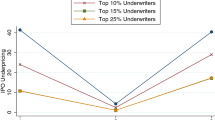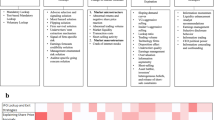Abstract
The paper examines the determinants of stabilization and its impact on the aftermarket prices. We use a unique dataset to relax several assumptions in the stabilization literature. We find that underwriters support IPO prices shortly after listing, particularly in cold markets and when demand is weak. We also show that stabilized IPOs are more common amongst reputable underwriters. This finding suggests that stabilization may be used as a mechanism to protect the underwriter’s reputation. It also implies that reputable underwriters may possess private information and price IPOs closer to their true values (i.e., higher than those indicated by the weak premarket demand). Consistent with the latter view, we show that stabilized IPOs are offered at higher prices and suffer less underpricing than those indicated by the premarket demand, firm characteristics and market-wide conditions. The post-IPO performance results indicate that stabilized IPOs are unlikely to be mispriced as their prices do not exhibit any significant reversal after the initial stabilization period. We conclude that stabilization may be superior to underpricing as it protects investors from purchasing overpriced IPOs, benefits issuers by reducing the total money “left on the table” and enhances the overall profitability of underwriters.
Similar content being viewed by others
Notes
Exceptions are: Boreiko and Lombardo (2009), who examine the determinants of underwriters’ decisions to stabilize Italian IPOs and the factors that influence stabilization intensity; Lombardo (2007), who provides a thorough comparison, from legal and economic perspectives, of regulation relating to the stabilization of IPOs in the European Union and the US; and Chung et al. (2000), who report that overallotment options (OAOs) are granted less frequently by Canadian IPOs, that there is a positive relation between underwriting fees and OAOs inclusion, and that OAOs do not play a significant role in the stabilization of Canadian IPOs.
Schultz and Zaman (1994, p. 202, fn. 2) suggest that, except if the security is sold on a when-distributed basis, Federal Reserve Regulation T allows investors to pay for their purchases within 7 days from the day that the security is made available by the issuer or is distributed (i.e., the closing date). The authors also indicate that brokers believe that a binding contract between the broker and the IPO investor does not exist until the customer has had a chance to carefully examine the final prospectus.
This is the date from which time underwriters were required to provide detailed information about their stabilization activities.
For introductions and placings, the shares are usually sold to a restricted circle of investors who are mainly institutions and wealthy individuals selected or approved by the issuer and/or underwriters. These offerings are excluded as they do not disclose information relating to their offerings. Similarly, firms transferred from GEM to the Main Board are excluded as they are not actually IPOs.
In the case of joint lead underwriters, the proceeds are split equally among them.
When we repeat the analysis using UndFreq instead of UndProc as a measure of underwriters’ reputations, our conclusions remain unchanged. Details are available upon request.
In order to obtain a better insight into the impact of self-selection adjustments on various determinants of underpricing, we estimate the parameters of the underpricing equations without the IMRs. Our (unreported) results suggest that self-selection adjustments affect the sign, the magnitude, and the statistical significance of the different explanatory variables. This evidence is consistent with the view that failure to control for choice selectivity can yield biased estimates of expected underpricing. More details on these results are available upon request.
Details of the estimation results are available upon request.
We also examined size-adjusted IPO returns, where the size-matched firm is a non-IPO firm (active with three-year trading history) closest in market value of equity to the IPO firm in question, but the results remained unchanged.
Because the Jarque–Bera test suggests that the commission fees data is not normally distributed, the non-parametric Mann–Whitney test is likely to be reliable.
References
Aggarwal R (2000) Stabilization activities by underwriters after initial public offerings. J Financ 55(3):1075–1103
Barry CB, Brown SJ (1985) Differential information and security market equilibrium. J Financ Quant Anal 20(4):407–422
Benveniste LM, Spindt PA (1989) How investment bankers determine the offer price and allocation of new issues? J Financ Econ 24(2):343–361
Benveniste LM, Busaba WY, Wilhelm WJ (1996) Price stabilization as a bonding mechanism in new equity issues. J Financ Econ 42(2):223–255
Boehmer E, Fishe R (2004) Underwriter short covering in the IPO aftermarket: a clinical study. J Corp Finance 10(4):575–594
Boreiko D, Lombardo S (2009) Stabilisation activity in Italian IPOs. Working paper, European Corporate Governance Institute
Chen G, Firth E, Kim JB (2000) The post-issue market performance of initial public offerings in China new stock markets. Rev Quant Financ Acc 14(4):319–339
Chen G, Firth E, Krishnan GV (2001) Earnings forecast errors in IPO prospectuses and their association with initial stock returns. J Multinat Finan Manage 11(2):225–240
Cheung YL, Cheung SL, Ho RYK (1993) Listing requirements, uncertainty, and underpricing of IPOs. Asia–Pacific Financial and Forecasting Research Centre Technical Report No. 93-1
Chowdhry B, Nanda V (1996) Stabilization, syndication, and pricing of IPOs. J Financ Quant Anal 31(1):25–42
Chung R, Kryzanowski L, Rakita I (2000) The relationship between overallotment options, underwriting fees and price stabilisation for Canadian IPOs. Multinat Finance J 4:5–34
Dalton DR (2003) Initial public offerings as a web of conflicts of interest: an empirical assessment. Bus Ethics Q 33:289–314
Dimovski W, Philavanh S, Brooks R (2011) Underwriter reputation and underpricing: evidence from the Australian IPO market. Rev Quant Financ Acc 37(4):409–426
Dunbar CG (2000) Factors affecting investment bank initial public offering market share. J Financ Econ 55(1):3–41
Ellis K, Michaely R, O’hara M (2000) When the underwriter is the market maker: an examination of trading in the IPO aftermarket. J Financ 55(3):1039–1074
Fishe RPH (2002) How stock flippers affect IPO pricing and stabilization. J Financ Quant Anal 37(2):319–340
Gompers PA, Lerner J (2003) The really long-run performance of initial public offerings: the pre-Nasdaq evidence. J Financ 58(4):1355–1392
Hanley KW, Kumar AA, Seguin PJ (1993) Price stabilization in the market for new issues. J Financ Econ 34(2):177–197
Heckman J (1976) Sample selection bias with continuous and discrete endogenous variables and structure shifts. In: Goldfield SM, Quant RE (eds) Studies in non-linear estimation. Ballinger, Cambridge, pp 235–272
Heckman J (1979) Sample selection bias as a specification error. Econometrica 47(1):153–161
Hoberg C (2007) The underwriter persistence phenomenon. J Financ 62(3):1169–1206
Jenkinson T, Jones H (2007) The economics of IPO stabilization syndicates and naked shorts. Eur Financ Manag 13(4):616–642
Lee L (1978) Unionism and wage rates: a simultaneous equations model with qualitative and limited dependent variables. Int Econ Rev 19(2):415–433
Lewellen K (2006) Risk, reputation, and IPO price support. J Financ 61(2):613–653
Lombardo S (2007) The stabilisation of the share of IPOs in the United States and the European Union. Eur Bus Organisation Law Rev 8:521–565
Loughran T, Ritter JR (1995) The new issues puzzle. J Financ 50(1):23–51
Mazouz K, Saadouni K, Yin S (2008) Warrants in IPOs: evidence from Hong Kong. Pac Basin Financ J 16(5):539–554
McGuinness P (1992) An examination of the underpricing of initial public offerings in Hong Kong: 1980–1990. J Bus Finance Acc 19(2):165–186
Nanda V, Yun Y (1997) Reputation and financial intermediation: an empirical investigation of the impact of IPO mispricing on underwriter market value. J Financ Intermed 6(1):39–63
Ng CK, Smith RL (1996) Determinants of contract choice: the use of warrants to compensate underwriters of seasoned equity issues. J Financ 51(1):363–380
Prabhala NR, Puri M (1999) How does underwriter price support affect IPOs: empirical evidence. Working paper, Yale University and Stanford University
Ritter JR (1984) The hot issue market of 1980. J Bus 57(2):215–240
Rock K (1986) Why new issues are underpriced. J Financ Econ 15:187–212
Ruud JS (1993) Underwriter price support and the IPO underpricing puzzle. J Financ Econ 34(2):135–151
Schultz PH, Zaman MA (1994) Aftermarket support and underpricing of initial public offerings. J Financ Econ 35(2):199–219
Smith CW (1986) Raising capital: theory and evidence. Midland Corp Financ J 4(1):6–22
Welch I (1992) Sequential sales, learning and cascades. J Financ 47(2):695–732
Zhang D (2004) Why do IPO underwriters allocate extra shares when they expect to buy them back? J Financ Quant Anal 39(3):571–594
Acknowledgments
The authors would like to thank the Editor Prof. Cheng-Few Lee and two anonymous reviewers for their thoughtful comments and suggestions.
Author information
Authors and Affiliations
Corresponding author
Rights and permissions
About this article
Cite this article
Mazouz, K., Agyei-Ampomah, S., Saadouni, B. et al. Stabilization and the aftermarket prices of initial public offerings. Rev Quant Finan Acc 41, 417–439 (2013). https://doi.org/10.1007/s11156-012-0315-y
Published:
Issue Date:
DOI: https://doi.org/10.1007/s11156-012-0315-y




